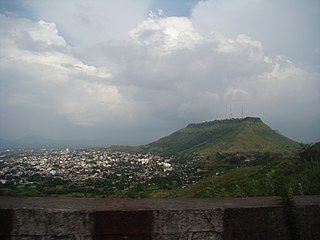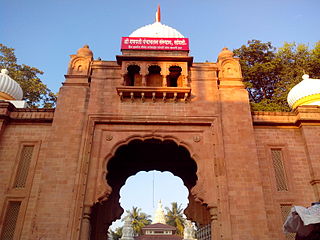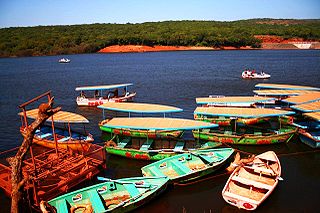Related Research Articles

The Krishna River is a river in the Deccan plateau and is the third-longest river in India, after the Ganges and Godavari. It is also the fourth-largest in terms of water inflows and river basin area in India, after the Ganges, Indus and Godavari. The river, also called Krishnaveni, it is 1,400 kilometres (870 mi) long and its length in Maharashtra is 282 kilometres. It is a major source of irrigation in the Indian states of Maharashtra, Karnataka, Telangana and Andhra Pradesh.
Desh is a region adjacent to the Western Ghats between the Godavari River and Krishna River, a part of Deccan Plateau, in the states of Maharashtra, Karnataka, and Andhra Pradesh. The region is hilly and slopes towards the east, and is drained by the upper reaches of the Godavari and Krishna rivers and their tributaries.
Mahabaleshwar is a small town and a municipal council in Satara district, Maharashtra, India. It is a place of pilgrimage for Hindus because Krishna river has its origin here. The British colonial rulers developed the town as a hill station, and served as the summer capital of Bombay Presidency during the British Raj.

Satara is a city located in the Satara District of Maharashtra state of India, near the confluence of the river Krishna and its tributary, the Venna. The city was established in the 16th century and was the seat of the Chhatrapati of Maratha Empire, Shahu I. It is the headquarters of Satara Tehsil, as well as the Satara District. The city gets its name from the seven forts (Sat-Tara) which are around the city. The city is known as a Soldier's city as well as Pensioner's city.

The Koyna River is a tributary of the Krishna River which originates in Mahableshwar, Satara district, western Maharashtra, India. It rises near Mahabaleshwar, a famous hill station in the Western Ghats. Unlike most of the other rivers in Maharashtra which flow East-West direction, the Koyna river flows in North-South direction. The Koyna River is famous for the Koyna Dam and the Koyna Hydroelectric Project. Koyna Hydroelectric Project is the 2nd largest completed hydroelectric project in India. The reservoir – Shivasagar Lake, is a huge lake of 50 km in length.

Pratapgad is a mountain fort located in Satara district, in the Western Indian state of Maharashtra.The fort is situated 24 kilometres from the Mahabaleshwar hill station. The fort is now a popular tourist destination.
Wai is a town in Satara district of Maharashtra state in India. Located on the Krishna River, Wai was a prominent town during the Peshwa era. Two important Marathi Brahmin from ruling families had their origins here: Rani Lakshmibai of Jhansi and Gopikabai, wife of Nanasaheb Peshwa.

Satara district is a district of Maharashtra state in western India with an area of 10,480 km2 (4,050 sq mi) and a population of 3,003,741 of which 14.17% were urban. Satara is the capital of the district and other major towns include Medha, Wai, Karad, Koregaon, Rahimatpur, Dahiwadi, Koynanagar, Phaltan, Lonand, Mahabaleshwar, Panchgani, Vaduj and Mhaswad. This district comes under Pune Administrative Division along with Pune, Sangli, Solapur and Kolhapur. The district of Pune bounds it to the north, Raigad bounds it to the north-west, Solapur the east, Sangli to the south, and Ratnagiri to the west.

Sangli district is a district of Maharashtra state in India. Sangli city is the district headquarters. It is bordered by Satara district, Solapur district to the North, Karnataka state to South-East, by Kolhapur district to South-West and by narrow portion in East side to Ratnagiri district. It is present on the southern tip of Maharashtra.

Karad is a city in Satara district of Indian state of Maharashtra and it is 320 km (180.19 miles) from Mumbai, 72 km From Sangli and 159 km from Pune. It lies at the confluence of Koyna River and the Krishna River known as the "Priti sangam". The two rivers originate at Mahabaleshwar, which is around 100 km from Karad. They diverge at their origin and travel about the same distance to meet again in Karad. The rivers meet exactly head-on, thus forming the letter "T" which is the only head-on confluence in the world. Hence Krishna and Koyna river's confluence is called Preeti Sangam, meaning Confluence of Love. Karad is well known for sugar production and is known as the sugar bowl of Maharashtra owing to the presence of many sugar factories in and around Karad. It is considered an important educational hub in Western Maharashtra due to the presence of many prestigious educational institutes. This place is also known as the resting place (Samadhi) of the first chief minister of Maharashtra Shri. Yashwantrao Chavan situated at the confluence of the Krishna and Koyana rivers.

Bhushangad is a hill fort in the Khatav taluk of the Satara district of Maharashtra, India. It is oval in shape, and rises 600 feet (180 m) above the surrounding plain. Its top is flat, and measures to be about 300 square yards (250 m2) in area.

Venna Lake is one of the tourist attractions of Mahabaleshwar in Maharashtra state in India. The lake was constructed by Shri Appasaheb Maharaj, who was Raja (King) of Satara in 1842.

Savitri River is one of the five rivers which originate from Mahabaleshwar in Maharashtra state in India. It originates at Savitri point near Mahabaleshwar and flows through the bankot village and directly goes to Arabian sea Raigad district and eventually meets Arabian Sea at Harehareshwar. It passes through rocky and hilly terrain of western ghats till Poladpur and further through the towns of Mahad, Mangaon and Shrivardhan Tehsil (taluka). There are a number of Shiva temples along the banks of river Savitri. Many other small rivers get merged into it at Kapade, Poladpur and Birwadi. Its major tributary is the Kal River which enters from the right (north) near Dasgaon.

Dhom Dam is an earthfill and gravity dam on Krishna river near Wai in state of Maharashtra in India. Its co-ordinates are 17.9815° N, 73.7954° E.
Kondhawali is a town in Satara District, near Mahabaleshwar in Maharashtra, India.
The Gayatri River is a tributary of the Krishna River in western Maharashtra, India. It rises in Panchaganga temple in old Mahableshwar, a hill station in the Western Ghats.
Khambatki Ghat is a mountain pass on Pune-Kolhapur section of National Highway 48 in Maharashtra, India. This ghat lies in the Sahyadri mountain ranges and has picturesque mountain-scapes and a pleasant climate.

Old Mahabaleshwar, also known as Kshetra Mahabaleshwar, is a historical village in Mahabaleshwar, of the Satara district in the Indian state of Maharashtra. It is a hill station located near the Western Ghats, seven kilometers from Mahabaleshwar. It is home to three temples: the Panchganga temple, Mahabaleshwar temple, and Krishna temple.

Vele is a village in the Western region of Maharashtra state in India. It is located in Satara district of Maharashtra. Before it was a part of Bombay State and Princely state of Satara. It is located adjacent to Kanher Dam built on Venna River. There is a big temple of Bhairava at the village entrance. Also there are number of temples in closed vicinity of village. Surrounded by greenery and farms, agriculture is the main occupation in the village with more than 80% of the total area being used for agricultural activities. Though agriculture constitutes a mainstay of the economy of this village, besides a sizeable population working at various plum government positions does bolster the financial position.
References
- ↑ "Venna River, Maharashtra". indiapl.com. Retrieved 13 September 2021.
